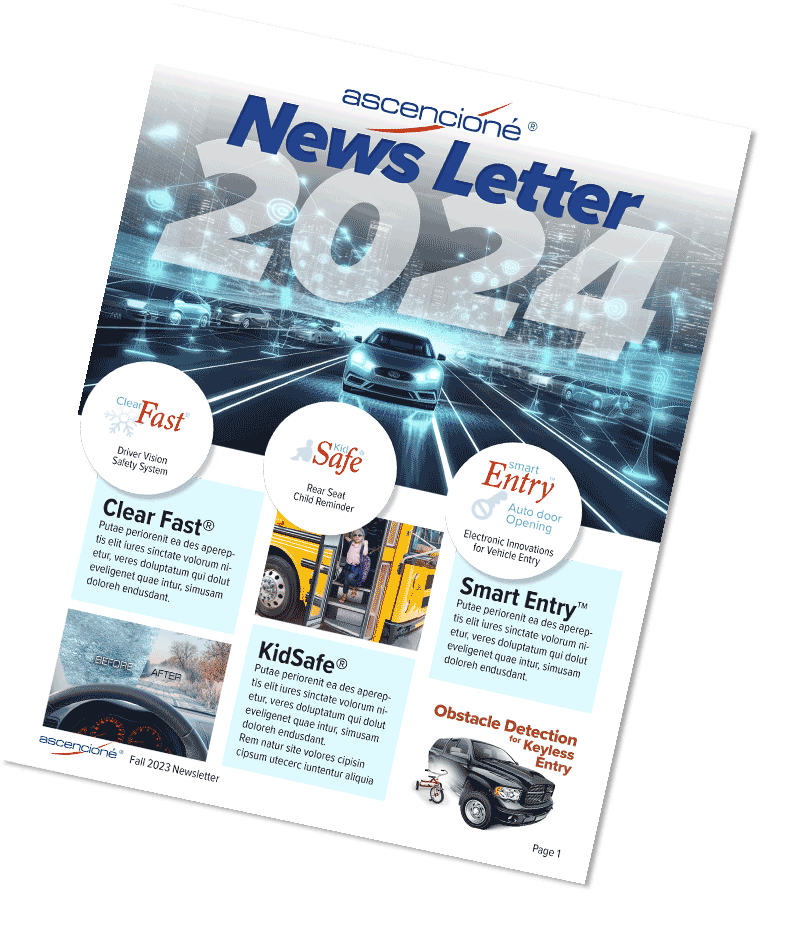“Sense” of Sense, Compute, and Control

Table of Contents
Sense
Sensors in Automotive Technology: A Comprehensive Look at Sensor Types and Their Measurement Techniques
Sensors play a pivotal role in the modern automotive industry, enhancing vehicle performance, safety, and comfort. This comprehensive overview explores the diverse range of sensor technologies, their measurement techniques, and their critical applications in automotive systems.
Significance of Sensors in the Automotive Industry
Sensors are integral to the functionality and safety of contemporary vehicles. They provide real-time data to various control units, enabling precise management of vehicle dynamics, environmental conditions, and internal system states. This data-driven approach ensures improved fuel efficiency, reduced emissions, enhanced safety features, and superior driving experiences.
Ascencioné® is a next-generation, advanced sensing electronics company that focuses in on “Sense, Compute, & Control® systems” So much so that we’ve registered those three words to offer higher levels of safety and convenience.
Sense:
- Sense because our sensors measure: Linear and rotary position, Distance / location, Velocity, Fluid level / flow, Pressure, Temperature, Light, Acceleration, Force, Touch, and Proximity.
Compute:
- Compute because our processors think: Embedded systems, Logic & intelligence, Electronic hardware, Filtering, Signal processing, Signal analysis, PID control, Software algorithms, Operating systems, Data communications, User interface /UX.
and Control®:
Control because our controllers empower: Mechatronic systems, Motor control, Actuators, Kinematics, Open / closed loop, Electric / fluid power, Lighting, Displays, Haptics, and Rheologial fluid torque
In this article we will focus on the sense portion of Sense, Compute, & Control®. Overview of Various Sensor Types and Their Importance.
Linear and Rotary Position Sensors
Measurement Techniques – Resistive Potentiometers:
These sensors measure position by varying resistance as a contact moves along a resistive track. When the contact point shifts, it alters the resistance, which can be measured and converted into positional data. This method is simple and cost-effective, making it ideal for many automotive applications where precision is required but extreme accuracy is not critical.
Optical Encoders:
Optical encoders use light and photodetectors to measure position by detecting changes in light patterns. A light source, typically an LED, illuminates a code disk or strip with specific patterns. As the code disk moves, these patterns change and are detected by photodetectors, allowing for accurate position measurement. This technique offers high precision and is commonly used in applications requiring fine control over movement.
Applications and Advantages: – Throttle Position Sensors:
These sensors monitor the position of the throttle in the engine to ensure an optimal air-fuel mixture. By accurately determining the throttle position, the engine control unit can adjust the fuel injection and air intake, improving engine efficiency and performance. This leads to better fuel economy and lower emissions.
Steering Angle Sensors:
Steering angle sensors measure the angle of the steering wheel, providing crucial data for stability control and advanced driver-assistance systems (ADAS). This information helps systems like electronic stability control (ESC) and lane-keeping assist (LKA) maintain vehicle stability and enhance safety by adjusting steering inputs as needed.
Our products that include linear and rotary position sensors: kidSafe® for a Bus Door, Chrysler ICS Centerstack Electronic Display, Door obstacle detection System, gm Motorized Vents, Stellantis Pulse with Modulation – Fuel Pump Control Module
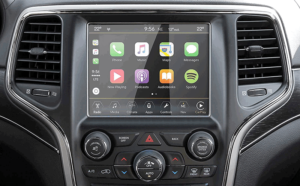
Distance/Location Sensing Technology
Techniques – Ultrasonic Sensors:
These sensors emit high-frequency sound waves and measure the time taken for the echo to return after bouncing off an object. By calculating the time delay, the sensor can determine the distance to the object. Ultrasonic sensors are widely used for short-range distance measurement due to their reliability and simplicity.
Global Positioning System (GPS):
GPS utilizes signals from multiple satellites to determine the precise location of the vehicle. By triangulating the signals from at least four satellites, the GPS receiver calculates the vehicle’s position in terms of latitude, longitude, and altitude. This technology provides accurate and real-time location data essential for navigation and tracking.
Implementation – Parking Assistance Systems:
Ultrasonic sensors are commonly used in parking assistance systems to detect obstacles around the vehicle. These sensors help drivers by providing audible or visual alerts when objects are detected, making parking safer and easier, especially in tight spaces.
Navigation Systems:
GPS technology is integral to modern navigation systems, offering real-time location data and route guidance. These systems help drivers find the best routes, avoid traffic congestion, and reach their destinations efficiently, enhancing the overall driving experience.
Our products that include Distance/Location Sensing Technology: kidSafe® for a Bus Door, Door obstacle detection System
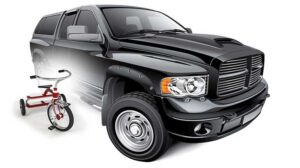
Velocity Sensing Mechanisms
Doppler Effect Radar Sensors:
These sensors measure speed by detecting changes in the frequency of reflected radar waves. When a radar wave hits a moving object, the frequency of the reflected wave shifts proportionally to the object’s speed. This shift, known as the Doppler effect, allows the sensor to calculate the object’s velocity accurately.
Wheel Speed Sensors:
Wheel speed sensors use magnetic fields to determine the rotational speed of each wheel. These sensors typically consist of a toothed wheel (tone ring) and a magnetic sensor. As the wheel rotates, the teeth cause fluctuations in the magnetic field, which are detected and converted into speed data. This information is critical for systems like anti-lock braking systems (ABS) and traction control.
Anti-lock Braking Systems (ABS):
ABS prevents wheel lock-up during braking by continuously monitoring wheel speed and modulating brake pressure accordingly. This ensures that the wheels maintain traction with the road surface, reducing the risk of skidding and enhancing vehicle control during emergency braking.
Traction Control Systems (TCS):
Traction control systems enhance vehicle stability by controlling wheel slip. By monitoring wheel speed and detecting loss of traction, TCS adjusts engine power and applies brake force to specific wheels, helping maintain optimal grip and stability, especially on slippery surfaces.
Our products that include velocity sensing mechanisms: Faraday door obstacle detection system DOS – Radar
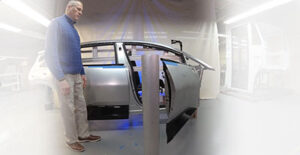
Fluid Level/Flow Sensors
Techniques – Capacitive Level Sensors:
These sensors measure changes in capacitance caused by the level of fluid. A capacitive sensor consists of two conductive plates separated by a dielectric material. As the fluid level changes, the dielectric constant between the plates varies, altering the capacitance, which is measured and used to determine the fluid level.
Flow Meters:
Flow meters measure the rate of fluid flow using various techniques, such as turbine, ultrasonic, or thermal methods. Turbine flow meters use a rotating turbine to measure flow rate, while ultrasonic flow meters use sound waves to calculate flow by measuring the time it takes for the waves to travel through the fluid. Thermal flow meters measure flow by detecting temperature changes in the fluid.
Applications – Engine Oil Level Sensors:
These sensors ensure adequate lubrication by monitoring oil levels. Maintaining proper oil levels is crucial for engine performance and longevity, as insufficient lubrication can lead to increased friction, overheating, and potential engine damage.
Fuel Flow Sensors:
Fuel flow sensors measure fuel consumption to optimize engine performance. By providing real-time data on fuel usage, these sensors help adjust the air-fuel mixture, improving efficiency and reducing emissions. Accurate fuel flow measurement is essential for achieving optimal engine performance and meeting regulatory standards.
Our products that include fluid level/flow sensors: SPS J1939 ECU, Clearfast Induction Fluid Heating System – FLS coolant level

Pressure Sensing Technology
Measurement Principles – Piezoresistive Pressure Sensors:
These sensors change resistance in response to pressure variations. A piezoresistive element, typically made of silicon, deforms under pressure, causing a change in electrical resistance. This change is measured and converted into pressure data. Piezoresistive sensors are known for their high sensitivity and accuracy.
Capacitive Pressure Sensors:
Capacitive pressure sensors detect pressure changes by measuring variations in capacitance. These sensors consist of two conductive plates separated by a dielectric material. When pressure is applied, the distance between the plates changes, altering the capacitance. This change is measured and used to determine the pressure.
Utilization – Tire Pressure Monitoring Systems (TPMS):
TPMS maintain proper tire pressure for safety and efficiency. These systems continuously monitor tire pressure and alert the driver if the pressure falls below a safe level. Maintaining correct tire pressure improves fuel efficiency, extends tire life, and enhances vehicle handling and safety.
Engine Manifold Pressure Sensors:
These sensors optimize engine performance by monitoring air intake pressure. The data provided by manifold pressure sensors is used to adjust fuel injection and ignition timing, ensuring optimal combustion and improving engine efficiency and power output.
Our products that include pressure sensing technology: Advanced Product Demos for Ascencioné® kidSafe® Anti-trap

Temperature Sensing Devices
Measurement Techniques – Thermocouples:
Thermocouples generate a voltage in response to temperature differences. They consist of two different metals joined at one end. When exposed to temperature changes, a voltage is produced at the junction, which is proportional to the temperature difference. Thermocouples are widely used for their broad temperature range and fast response time.
Resistance Temperature Detectors (RTDs):
RTDs measure temperature by correlating resistance changes with temperature. An RTD is typically made of pure platinum and provides highly accurate and stable temperature measurements. As the temperature changes, the electrical resistance of the RTD element changes, which is measured and converted into temperature data.
Role – Engine Coolant Temperature Sensors:
These sensors prevent overheating by monitoring coolant temperature. Accurate temperature measurement is essential for maintaining engine performance and preventing damage. The data from these sensors is used to adjust the cooling system and ensure the engine operates within the optimal temperature range.
Ambient Air Temperature Sensors:
Ambient air temperature sensors adjust climate control systems based on external temperatures. By providing real-time temperature data, these sensors help maintain a comfortable cabin environment and improve the efficiency of heating and cooling systems.
Our products that include temperature sensing devices: Military Smart Start System S3 control remote switching, FLS Coolant
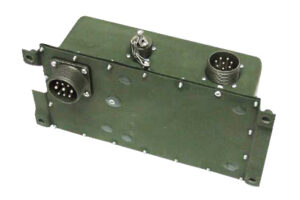
Light Sensors in Automotive Applications
Types and Functions – Photodiodes:
Photodiodes convert light into electrical current for various lighting applications. When light strikes the photodiode, it generates an electric current proportional to the light intensity. This property is used in applications such as automatic headlight control, where the sensor detects ambient light levels and adjusts the headlights accordingly.
Light Dependent Resistors (LDRs):
LDRs change resistance based on light intensity. When exposed to light, the resistance of an LDR decreases, allowing more current to flow through the circuit. This characteristic is used in applications like rain-sensing wipers, where the sensor detects changes in light patterns caused by raindrops and activates the wipers.
Integration – Automatic Headlight Control:
Automatic headlight control systems use photodiodes to adjust headlights based on ambient light conditions. This feature improves driving safety by ensuring optimal visibility without manual intervention, automatically switching between high and low beams as needed.
Rain-Sensing Wipers:
Rain-sensing wipers activate automatically when detecting rain. LDRs or optical sensors detect raindrops on the windshield, triggering the wipers to start. This feature enhances driver convenience and safety by maintaining a clear view during adverse weather conditions.
Our products that include light sensors in automotive applications: ICS Centerstack Electronic Display, Ford B-Pillar KETS, ALS
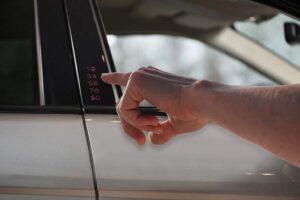
Acceleration Sensing Mechanisms
Techniques – Microelectromechanical Systems (MEMS) Accelerometers:
MEMS accelerometers detect acceleration using micro-scale devices. These sensors consist of tiny mechanical structures that move in response to acceleration forces. The movement alters the capacitance or resistance within the sensor, which is measured and converted into acceleration data. MEMS accelerometers are compact, low-power, and highly accurate.
Piezoelectric Accelerometers:
Piezoelectric accelerometers measure acceleration through changes in piezoelectric material properties. When subjected to acceleration forces, the piezoelectric material generates an electrical charge proportional to the force. This charge is measured and used to determine the acceleration. These sensors are known for their durability and high-frequency response.
Impact – Electronic Stability Control (ESC):
ESC systems maintain vehicle stability by monitoring acceleration and steering inputs. Accelerometers provide real-time data on the vehicle’s movements, allowing the ESC system to adjust braking and throttle inputs to prevent skidding and maintain control, especially during sudden maneuvers or slippery conditions.
Airbag Deployment Systems:
Airbag deployment systems use accelerometers to trigger airbags in response to sudden deceleration. When a significant impact is detected, the sensors send a signal to deploy the airbags, protecting occupants from injury. Accurate and fast acceleration measurement is critical for the timely and effective deployment of airbags.
Our products that include acceleration sensing mechanisms: kidSafe bus door, Optical Apes

Force and Touch Sensors
Measurement Principles – Strain Gauge Sensors:
Strain gauge sensors measure force based on changes in resistance due to deformation. When a force is applied to the sensor, it deforms, causing a change in electrical resistance. This change is measured and converted into force data. Strain gauge sensors are widely used for their accuracy and reliability in measuring mechanical loads.
Capacitive Touch Sensors:
Capacitive touch sensors detect touch by measuring changes in capacitance. These sensors consist of conductive layers separated by a dielectric material. When a finger or conductive object approaches the sensor, it alters the capacitance, which is detected and processed to determine the touch location. Capacitive touch sensors are commonly used in infotainment systems for their responsiveness and durability.
Integration – Occupant Detection for Airbag Deployment:
Occupant detection systems use force sensors to ensure airbags deploy based on occupant presence and position. These sensors detect the weight and position of occupants in the vehicle, providing data to the airbag control unit to adjust deployment force and timing, enhancing safety.
Touch-Sensitive Infotainment Displays:
Touch-sensitive displays use capacitive touch sensors to provide intuitive user interfaces for vehicle controls. These displays allow drivers and passengers to interact with the infotainment system easily, enhancing the overall user experience with features like navigation, media control, and vehicle settings.
Our products that include force and touch sensors: kidSafe bus door
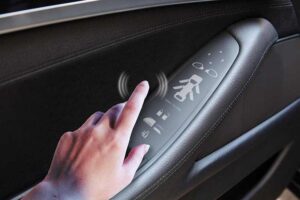
Proximity Sensors in Automotive Technology
Techniques – Inductive Proximity Sensors
Inductive proximity sensors detect metal objects through changes in inductance. When a metal object approaches the sensor, it alters the inductance of the coil within the sensor, generating a signal that indicates the presence of the object. These sensors are robust and reliable for detecting metallic objects in various automotive applications.
Capacitive Proximity Sensors:
Capacitive proximity sensors sense objects based on changes in capacitance. These sensors consist of conductive plates separated by a dielectric material. When an object enters the sensor’s field, it alters the capacitance, which is measured and used to detect the object’s presence. Capacitive sensors are versatile and can detect both metallic and non-metallic objects.
Applications – Adaptive Cruise Control (ACC):
ACC systems use proximity sensors to maintain safe distances from other vehicles. These sensors continuously monitor the distance to the vehicle ahead and adjust the speed to maintain a safe following distance, enhancing driving safety and convenience.
Blind Spot Detection Systems:
Blind spot detection systems use proximity sensors to alert drivers to vehicles in their blind spots. These sensors monitor areas around the vehicle that are not visible to the driver and provide warnings when other vehicles are detected, helping prevent collisions during lane changes.
Our products that include proximity sensors in automotive technology: kidSafe® for a Bus Door, Door obstacle detection System

Sensing Final Thoughts
The diverse range of sensor technologies in the automotive industry enhances vehicle performance, safety, and comfort. As automotive technology continues to evolve, future trends and innovations in sensor integration will further optimize vehicle systems, making driving safer and more efficient.


